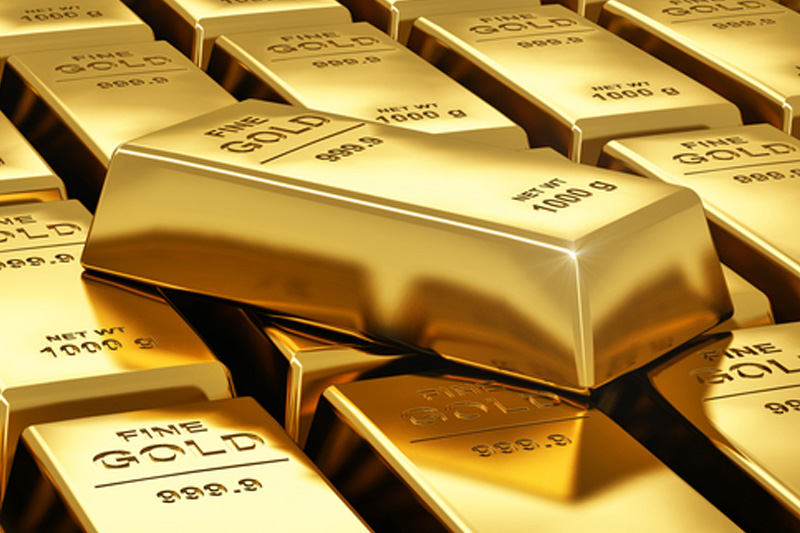Investing.com -- Gold surged by as much as $30 an ounce drawing near 12-month highs reached earlier in the month, as investors engaged in a flight to safety amid mounting concerns on the sweeping effects of crashing oil prices on global markets overall.
On Wednesday, Royal Dutch Shell A (N:RDSa) announced that it is shutting down its shale resources unit while parting ways with U.S. country chairman Marvin Odum, as part of a broad cost-cutting measure in response to its worst year of revenues in more than a decade. It transpired one day after Saudi Arabia oil minister Ali al-Naimi reiterated that the kingdom will under no circumstances slash production in order to bolster record-low prices. A wave of uncertainty in the oil industry has weighed on major banks, whose heavy exposure to oil and gas debt could lead to billions of dollars in credit losses. JPMorgan Chase & Co (N:JPM) disclosed on Tuesday at its annual investor day that it is reserving an additional $600 million in the first quarter to cover energy and commodity loans, raising its total exposure to $1.6 billion. More troubling, the world's largest financial institution said it will be forced to double the amount if oil prices fall to $25 a barrel over the next 18 months.
As a result investors have sought shelter in safe-havens such as gold, government bonds and the Japanese yen.
On the Comex division of the New York Mercantile Exchange, gold for April delivery traded in a broad range between $1,222.70 and $1,254.20 an ounce before settling at $1,238.40, up 15.80 or 1.29% on the session. Gold posted its fourth move of at least 1% in a positive or negative direction over the last five sessions, underscoring the extreme volatility in global financial markets of late. The precious metal is up by approximately 16% on the new year and is on pace for its strongest opening quarters in nearly 30 years.
Gold likely gained support at $1,063.20, the low from January 4 and was met with resistance at $1,260.80, the high from Feb. 11.
The dollar retreated from three-week highs reached in the European afternoon session, following the release of disappointing economic data in the U.S. The U.S. Commerce Department said Wednesday that new home sales plummeted 9.2% to a seasonally-adjusted 494,000, sharply below expectations for a 4.4% decline to 520,000. Sales in the West, a critical region for the new housing market, plunged 32% on the month. For the year, new home sales in the West, South and Midwest regions of the U.S. have fallen into negative territory. Separately, the Purchasing Managers Index (PMI) Services' Flash tumbled to 49.8 in February, dropping to its lowest level since October, 2013. Analysts expected the reading to stay flat at 53.7.
The U.S. Dollar Index, which measures the strength of the greenback versus a basket of six other major currencies, fell more than 0.10% to an intraday low of 97.24. Since reaching 12-month highs in late-November, the index has dropped roughly 2%.
Dollar-denominated commodities such as gold become more expensive for foreign purchasers when the dollar appreciates.
Investors await a busy day of economic headlines on Friday when the second estimate of fourth quarter GDP and Personal Income and Outlays for January are released. The Core PCE Index, the Federal Reserve's preferred gauge for inflation, is expected to increase by 0.2% from December's total. Following the release, a trio of Fed policymakers, San Francisco Fed president John Williams and Fed governors Jerome Powell and Lael Brainard, are scheduled to deliver speeches on monetary policy and the economy.
On Tuesday evening, Fed governor Stanley Fischer said that members of the Federal Open Market Committee are still uncertain on whether they will raise short-term interest rates at their next meeting in three weeks. While Fischer said the FOMC could discuss the prospects of implementing a negative interest rate policy, he indicated that it is unlikely that the U.S. central bank will push rates into sub-zero territory.
Any rate hikes by the Fed this year are viewed as bearish for gold, which struggles to compete with high-yield bearing assets in rising rate environments.
Silver for March delivery added 0.055% to 15.295 an ounce.
Copper for March delivery lost 0.010 or 0.45% to 2.096 a pound.
